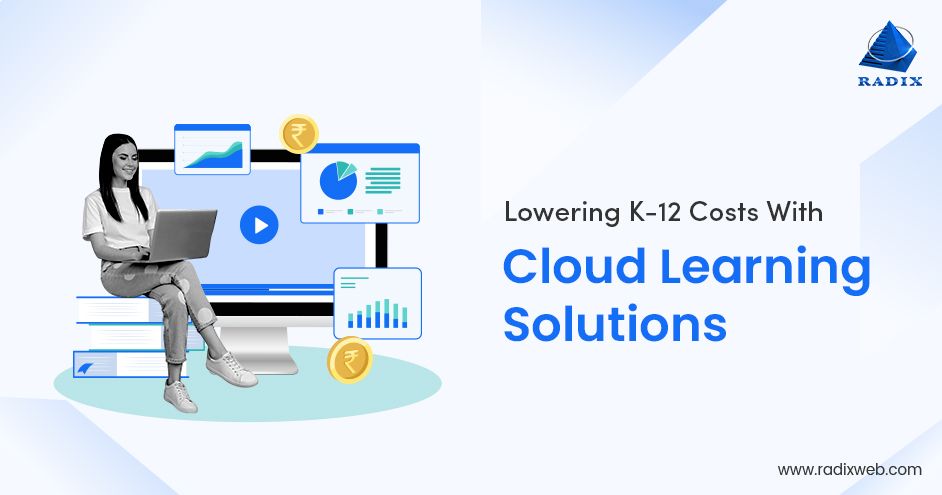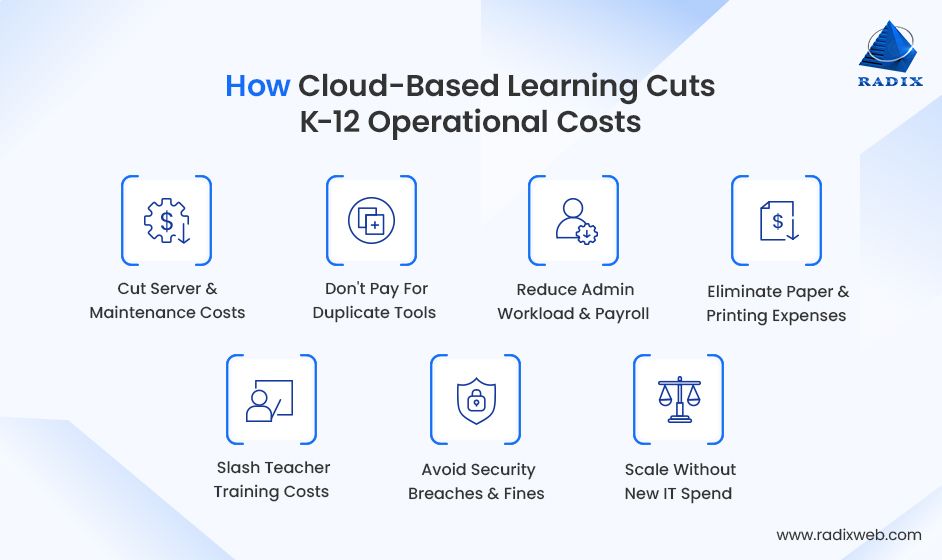Read More

Discover what’s next for AI in healthcare in 2026 - Get Access to the Full Report
How K-12 Schools Can Reduce Operational Costs with Cloud-Based Learning Solutions

Maitray Gadhavi

ON THIS PAGE
Your School is Paying to Stay Inefficient:Schools aren’t wasting money because they are careless. They are doing their best. Yet, lack of funds is their biggest challenge. The culprit? Bloated admin technology, outdated K-12 technology, and siloed on-prem systems. All this leaves little room for cost efficiency. These silent budget killers often mean K-12 schools operate over budget or have to compromise quality. However, there is a tested, scalable solution to reduce these costs without compromises - K-12 cloud computing for schools.In this blog, we will break down how the cloud quietly helps smart schools save thousands of dollars.
Depending on the size and location, running a K-12 school costs between $1 million to $3 million. Now, imagine if you could save 6 hours/week with technology. That will translate into huge savings, right? Without any reduction in the quality or level of education delivery.
Imagine all the avenues in K-12 education technology that could benefit from that extra time and resources.
Well, it isn’t just wishful thinking anymore. Cloud-based learning solutions can actually help you save on operational IT costs. And it is not just about saving money. It also improves accessibility and scalability.
Let’s break down seven key areas where cloud-based learning solutions reduce long-term operational expenses of K-12 education technology.
Dive in to make a strategic cost-saving decision.
7 Ways Cloud Computing for K-12 Education Technology Reduces Operational Costs
Let’s check out the cost advantages you can get with the use of K-12 cloud computing in education.

1. Lower IT Infrastructure & Maintenance Overheads
Maintaining servers, power backups, cooling systems, and IT support for legacy software is costly. In fact, the high cost of managing IT in K-12 schools has been a top eLearning challenge over decades. A 2013 study mentioned that. And so did another one in 2023.
With various options for cloud computing for schools, you no longer need to worry about physical servers or expensive hardware upgrades. Cloud providers handle the heavy lifting. So, data storage, uptime, backups, and disaster recovery are all taken care of.
These long-term savings on operational costs of cloud-based K-12 technology easily offset the cost of eLearning cloud application development.
2. Reduced Software Licensing Costs
On average, school districts use 2,591 EdTech tools every year. There is a tool for learning management, another for student information, one for communication, and so on. And each K-12 technology comes with its own subscription and maintenance fee.
Also, this means schools have to stitch together multiple software platforms, which leads to efficiency and engagement loss.
Cloud-based solutions, however, allow schools to consolidate these tools into a single, unified platform. It helps reduce duplicate spend and simplifies licensing.
Pay-as-you-go or usage-based pricing provided by some off-the-shelf cloud-based K-12 classrooms also ensures you’re only charged for what you actually use*.*
3. Efficiency in Administrative Tasks
Manual administrative work eats into both time and payroll. From student admissions to attendance tracking and report generation, traditional methods require constant staff input.
But cloud computing for K-12 education technology and AI are revolutionizing education administration. With smart admin modules, many of these workflows can be automated. This frees your administrative teams to focus on strategic initiatives. Tasks that once took hours now happen in minutes. So, there is no need for additional staffing or overtime.
4. Printing, Paper, and Distribution Expenses Drop
Schools spend $30,000 to $50,000 annually on paper alone. (That’s enough to fund an entire year’s worth of STEM kits!)
Add to that the annual cost of printed materials - assignments, report cards, newsletters. That's easily another $25,000 that could have been totally avoided. By shifting to digital content delivery, schools dramatically reduce this cost.
With cloud computing for schools, the time needed - for preparing the papers, printing, and distributing them - can also be minimized. Also, cloud-backed K-12 student information systems can automatically send updates to students (and parents!) This eliminates the risk of important notices being lost in the backpack.
5. More Accessible and Cost-Efficient Teacher Training
Professional development is essential for teachers and has benefits for the educational institutions they work with. But traditional training comes with travel, venue, and substitute teacher costs. With cloud-based systems, training becomes more flexible.
Schools can offer on-demand sessions, virtual workshops, and online certifications that educators can complete at their own pace, saving both time and money.
6. Enhanced Security, Without the Extra Spend
Data breaches and ransomware attacks are an increasing threat in the education sector. Building secure, on-premises infrastructure is not only complex but also expensive.
Here’s how expensive it is:
An average school incurs a $2.73 million loss due to a ransomware attack.
However, platforms that use cloud computing in education come with built-in security features like data encryption, automated backups, and access controls. Such K-12 technology reduces the need for separate cybersecurity tools or dedicated in-house security personnel. Plus, there is the peace of mind that you get knowing that you've got enterprise-grade security for your systems.
7. Flexible Scalability Without Infrastructure Investment
Traditional K-12 technology doesn't scale easily. Adding more students or expanding campuses often means new hardware, software licenses, and IT labor.
But if you get a cloud-based learning management system developed then scaling is as simple as adding more student seats to your system. You can expand capacity without adding new servers, buying extra licenses from third-party tools, or burdening your IT team. It’s growth, without the growing costs.
Bonus Benefit: Cloud Learning Solutions Are Greener
A decade-old study from Northwestern University confirmed that moving applications to the cloud can reduce IT-related energy consumption by up to 87%. With cloud systems becoming way more efficient than they were back then, the savings must have been amplified further.
That means cloud-based K-12 classrooms get lower electricity bills. But it also means a greener learning experience. Add to that the benefits that accrue from using less paper and online classes. This makes the use of cloud computing in education both cost effective and greener and gives you one more reason to get cloud-based LMS solutions developed.
Cloud Isn’t Just a Tech Decision. It’s a Cost Strategy
Cost-cutting doesn’t have to mean compromise. By rethinking how your school delivers learning, manages data, and communicates with stakeholders, you can unlock smarter, more sustainable operations.
From lowering infrastructure overhead to streamlining administrative tasks, cloud-based LMS solutions offer tangible ways to reduce operational costs. But savings depend on how well the digital transformation is executed.
That’s where Radixweb comes in.
Why Choose Radixweb for Cloud-Based LMS Development?At Radixweb, we’ve worked with forward-thinking educational institutions to help them adopt cloud-based systems. As an education software development company, we’ve also designed learning ecosystems that reduce redundancy, improve access, and simplify maintenance.But we don't just implement your K-12 technology solutions, we also:- Help optimize the solution for the best possible outcomes.- Ensure on-time, within-budget delivery- Offer long-term system maintenance and supportIn one of our recent projects, we helped a client eliminate the costs associated with regular classroom training by moving to the cloud.Our team of K-12 EdTech experts can also help you visualize the cost advantages of moving from your on-premises systems to cloud-based learning systems. Plus, we can help you plan the transition with minimal disruption and downtime.Important: We know cloud migration sounds daunting. That’s why we start with a low-risk pilot program, so you can see the benefits before committing full-scaleReady to cut costs without compromising learning? Start by scheduling your free strategy call
Frequently Asked Questions
What is cloud-based education?
What benefits do cloud-based platforms provide to schools?
What is the biggest benefit of schools storing data in the cloud?
What is the market size for the Cloud Computing Market in the K-12 Education Sector?
What if our current systems don’t integrate with the cloud?
Ready to brush up on something new? We've got more to read right this way.





